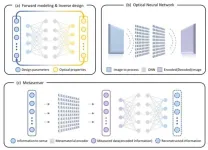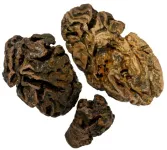(Press-News.org) FAIRFAX, Va. (March 20, 2024)—A minimally invasive technique that uses ice to freeze and destroy small, cancerous tumors has now been proven effective for breast cancer patients with large tumors, providing a new treatment path for those who are not candidates for surgery, according to new research to be presented at the Society of Interventional Radiology Annual Scientific Meeting in Salt Lake City.
“For patients who have larger tumors but can’t undergo surgery, this approach could be more effective than the current standard of care for patients who are not surgical candidates,” said Yolanda Bryce, M.D., an interventional radiologist at Memorial Sloan Kettering Cancer Center. “When treated with only radiation and hormonal therapy, tumors will eventually return. So, the fact that we saw only a 10% recurrence rate in our study is incredibly promising.”
Cryoablation is a minimally invasive treatment that uses imaging guidance such as ultrasound or computed tomography (CT) scan to locate tumors. An interventional radiologist will then insert small, needle-like probes into the breast to create an ice ball that surrounds the tumor, killing the cancer cells. When combined with hormonal therapy and radiation, patients can have nearly 100% of their tumors destroyed. If the tumors do grow, patients can be treated with cryoablation multiple times to control growth. The treatment has been successfully used to treat tumors smaller than 1.5 cm, but its effectiveness on larger tumors was not extensively demonstrated until now.
This retrospective study assessed outcomes for 60 patients who underwent cryoablation because they were not candidates for surgery or refused surgery after consultation with a breast surgeon due to age, cardiac issues, hypertension, or currently undergoing chemotherapy for another cancer. Their tumor sizes ranged from 0.3 – 9 cm with an average size of 2.5cm. Patients with tumors larger than 1.4 cm were treated with multiple probes (one probe placement for each centimeter of disease). In a follow-up after 16 months, the recurrence rate was just 10%.
“Surgery is still the best option for tumor removal, but there are thousands of women who, for various reasons, cannot have surgery,” said Bryce. “We are optimistic that this can give more women hope on their treatment journeys.”
The procedures were performed with local anesthesia or minimal sedation, depending on the eligibility and preference of the patient. The freeze-thaw cycle started with 5-10 minutes of freezing, followed by 5-8 minutes of passive thaw, and then 5-10 minutes freezing at 100% intensity. Patients were able to go home on the same day, following the treatment.
The researchers will continue to follow the patient cohort to collect data on long-term effectiveness and to better understand the impact that adjuvant (e.g. hormone therapy and radiation) therapies combined with cryoablation can have on this patient population.
Abstract #2: Breast cancer recurrence after cryoablation. J. Jean, Y. Bryce. Annual Scientific Meeting, March 23-28, 2024. This abstract can be found at sirmeeting.org after the embargo time.
###
About the Society of Interventional Radiology
The Society of Interventional Radiology is a nonprofit, professional medical society representing more than 8,000 practicing interventional radiology physicians, trainees, students, scientists and clinical associates, dedicated to improving patient care through the limitless potential of image-guided therapies. SIR’s members work in a variety of settings and at different professional levels—from medical students and residents to university faculty and private practice physicians. Visit sirweb.org. The Society of Interventional Radiology is holding its Annual Scientific Meeting in Salt Lake City March 23- 27, 2024. Visit sirmeeting.org.
END
Cryoablation highly effective for breast cancer patients with large tumors
Freezing treatment dissipates tumors in breast cancer patients who are not eligible for surgery
2024-03-20
ELSE PRESS RELEASES FROM THIS DATE:
More hysterectomies can be averted with earlier uterine artery embolization for postpartum hemorrhages
2024-03-20
FAIRFAX, Va. (March 20, 2024)—Early intervention with a minimally invasive treatment called uterine artery embolization (UAE) can help women avoid hysterectomy due to severe bleeding after childbirth, according to a new study being presented at the Society of Interventional Radiology Annual Scientific Meeting in Salt Lake City.
“These findings are important and may help more women avoid hysterectomy and other very serious complications of uncontrolled hemorrhage,” said lead author Younes Jahangiri, M.D., a third-year resident in the interventional and diagnostic radiology program at ...
New treatment option for prostate cancer shows successful outcomes
2024-03-20
FAIRFAX, Va. (March 20, 2024)—A minimally invasive treatment using MRI and transurethral ultrasound instead of surgery or radiation is effective in treating prostate cancer, according to new research to be presented at the Society of Interventional Radiology Annual Scientific Meeting in Salt Lake City. The traditional treatment options of radiation or surgery often come with a risk of side effects, including urinary incontinence and erectile dysfunction that cause significant morbidity and adverse lifestyle effects. Researchers said that some patients now have a durable alternative for whole-gland treatment with MRI-guided transurethral ultrasound ablation (TULSA) that does not preclude ...
ChatGPT is an effective tool for planning field work, school trips and even holidays
2024-03-20
Researchers exploring ways to utilise ChatGPT for work, say it could save organisations and individuals a lot of time and money when it comes to planning trips.
A new study, published in Innovations in Education and Teaching International (IETI), has tested whether ChatGPT can be used to design University field studies. It found that the free-to-use AI model is an effective tool for not only planning educational trips around the world, but also could be used by other industries.
The research, led by scientists from the University of Portsmouth and University of Plymouth, specifically ...
Metamaterials and AI converge, igniting innovative breakthroughs
2024-03-20
A research team, comprising Professor Junsuk Rho from the Department of Mechanical Engineering, the Department of Chemical Engineering, and the Department of Electrical Engineering, and PhD candidates Seokho Lee and Cherry Park from the Department of Mechanical Engineering at Pohang University of Science and Technology (POSTECH), has recently published a paper that highlights the next generation of research trends that combine metaphotonics research with artificial intelligence. The paper has been published in the international journal, Current Opinion in Solid State and Materials Science.
Metalenses have sparked a revolution in optics, drastically ...
This could be forever: New design prolongs the lifespan of plasma torches
2024-03-20
Thanks for a new design contributed by a research team led by Prof. ZHAO Peng from Hefei Institutes of Physical Science (HFIPS) of Chinese Academy of Sciences (CAS), the operation time for plasma torch was extended from several days to several years.
"We made the world's longest-lasting plasma torch," said Prof. ZHAO.
Plasma torches, devices that generate thermal plasma, are pivotal in various industries due to their ability to efficiently produce high-temperature plasma. It can be applied in many fields including low-carbon metallurgy, powder spheroidization, carbon material preparation, and advanced ...
People who are ‘double jointed’ may be at heightened risk of long COVID
2024-03-20
People who are ‘double jointed,’ a condition formally known as generalised joint hypermobility, may be at heightened risk of long COVID, suggests a case-control study published in the open access journal BMJ Public Health.
They were 30% more likely not to have fully recovered from COVID-19 infection than those without hypermobile joints, and to be experiencing the persistent fatigue associated with long COVID, the findings indicate.
Other than older age, the likelihood of developing long COVID seems to be greater ...
Air quality around planned new schools in England “alarmingly poor”
2024-03-20
The air quality around planned new schools in England is “alarmingly poor,” with 86% of sites exceeding World Health Organization (WHO) targets on major air pollutants, reveals an analysis published online in the Archives of Disease in Childhood.
The consequences for health from exposure to excessive levels of air pollutants are well known, say the researchers, who call for air quality assessment at all stages of planning to be mandated, and legislation and guidance to be updated as a matter of urgency.
Children are particularly vulnerable to the harmful effects of air pollution, because their bodies, organs, and immune systems are still developing, explain ...
Study reveals ‘cozy domesticity’ of prehistoric stilt-house dwellers in England’s ancient marshland
2024-03-20
A major report on the remains of a stilt village that was engulfed in flames almost 3,000 years ago reveals in unprecedented detail the daily lives of England’s prehistoric fenlanders.
Must Farm, a late Bronze Age settlement, dates to around 850BC, with University of Cambridge archaeologists unearthing four large wooden roundhouses and a square entranceway structure – all of which had been constructed on stilts above a slow-moving river.
The entire hamlet stood approximately two metres above the riverbed, with walkways bridging some of the main houses, and ...
New archive of ancient human brains challenges misconceptions of soft tissue preservation
2024-03-20
Soft tissue preservation in the geological record is relatively rare, and, except where deliberate intervention halts the process of decay (like embalming or freezing), the survival of entire organs is particularly unusual. The spontaneous preservation of the brain in the absence of any other soft tissues - that is, the brain’s survival amongst otherwise skeletonised remains - has historically been regarded as a ‘one-of-a kind’ phenomenon.
A new study conducted by researchers at the University of Oxford, led ...
Swallowable sensors could pinpoint gut movement problems for patients
2024-03-20
Scientists have developed an ingestible capsule dotted with sensors that can detect pressure in a patient’s guts and detect points of failure.
The ingestible system will give colorectal medical teams an unprecedented understanding of the movement of a patient’s digestive tract, or lack thereof.
Instead of simply taking images of inside the guts, the system will sense whether it’s contracting, how much pressure is exerted and exactly where it might be inactive.
The system has been tested in a synthetic gut and animals. A patent for the technology is pending.
The team from Heriot-Watt University and the University of Birmingham, with colleagues from the University ...
LAST 30 PRESS RELEASES:
When is it time to jump? The boiling frog problem of AI use in physics education
Twitter data reveals partisan divide in understanding why pollen season's getting worse
AI is quick but risky for updating old software
Revolutionizing biosecurity: new multi-omics framework to transform invasive species management
From ancient herb to modern medicine: new review unveils the multi-targeted healing potential of Borago officinalis
Building a global scientific community: Biological Diversity Journal announces dual recruitment of Editorial Board and Youth Editorial Board members
Microbes that break down antibiotics help protect ecosystems under drug pollution
Smart biochar that remembers pollutants offers a new way to clean water and recycle biomass
Rice genes matter more than domestication in shaping plant microbiomes
Ticking time bomb: Some farmers report as many as 70 tick encounters over a 6-month period
Turning garden and crop waste into plastics
Scientists discover ‘platypus galaxies’ in the early universe
Seeing thyroid cancer in a new light: when AI meets label-free imaging in the operating room
Neutrophil-to-lymphocyte ratio may aid risk stratification in depressive disorder
2026 Seismological Society of America Annual Meeting
AI-powered ECG analysis offers promising path for early detection of chronic obstructive pulmonary disease, says Mount Sinai researchers
GIMM uncovers flaws in lab-grown heart cells and paves the way for improved treatments
Cracking the evolutionary code of sleep
Medications could help the aging brain cope with surgery, memory impairment
Back pain linked to worse sleep years later in men over 65, according to study
CDC urges ‘shared decision-making’ on some childhood vaccines; many unclear about what that means
New research finds that an ‘equal treatment’ approach to economic opportunity advertising can backfire
Researchers create shape-shifting, self-navigating microparticles
Science army mobilizes to map US soil microbiome
Researchers develop new tools to turn grain crops into biosensors
Do supervised consumption sites bring increased crime? Study suggests that’s a myth
New mass spec innovation could transform research
Maternal nativity, race, and ethnicity and infant mortality in the US
Migration-related trauma among asylum seekers exposed to the migrant protection protocols
Jupiter’s moon Europa has a seafloor that may be quiet and lifeless
[Press-News.org] Cryoablation highly effective for breast cancer patients with large tumorsFreezing treatment dissipates tumors in breast cancer patients who are not eligible for surgery




